Sun 27 Nov 2011
A Review by Mike Tooney: TWO TV WESTERN WHODUNITS
Posted by Steve under Reviews , TV Westerns[12] Comments
Reviewed by Mike Tooney
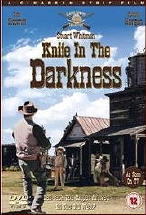
“Knife in the Darkness.” From the Cimarron Strip series (1967-68), Episode 18, January 25, 1968. Stuart Whitman (Marshal Jim Crown), Percy Herbert (Angus MacGregor), Randy Boone (Francis Wilde), Jill Townsend (Dulcey Coopersmith), David Canary, Philip Carey, Jeanne Cooper, Patrick Horgan, George Murdock, Tom Skerritt, Victoria Shaw, Karl Swenson, Grace Lee Whitney. Writer: Harlan Ellison. Music: Bernard Herrmann. Director: Charles R. Rondeau.
Since Jack the Ripper was never caught (at least publicly), it’s reasonable to speculate about what happened to him.
Science fiction maven Harlan Ellison chose to do some genre mashing with this script from Cimarron Strip, a relatively short-lived Western series (only one season of 23 episodes was produced). Ellison decided to have Jolly Jack (or someone who COULD have been the Ripper) immigrate to the United States and carry on his heinous activities — namely, slashing women to death.
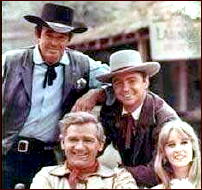
For rugged and normally imperturbable Marshal Jim Crown, life is hectic enough without importing criminals from overseas, so when a local prostitute is murdered, Ripper-style, his nerves start to fray just a wee bit — as this exchange between him and inn keeper Dulcey Coopersmith (the delicately beautiful Jill Townsend) would indicate:
Jim Crown: “I’m always worried when I work this town.”
Dulcey: “No, this is something special — this girl getting killed tonight.”
Jim Crown: “I told you when you came to Cimarron there’d be more killin’ than laughin’.”
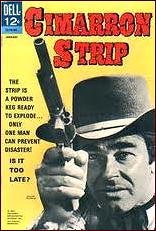
As in England, the Ripper follows his usual M.O.: targeting women in the dark. Unlike most shows in this series, nearly the entire episode takes place at night and is nicely photographed with deep, rich shadows and feeble light sources. Bernard Herrmann’s musical score adds even more dimension to the story. (It’s been said that nobody could do ominous like Bernard Herrmann.)
And this episode features a marvelous cast, including character actors who earned fame in other TV venues: David Canary (Bonanza, 94 episodes), Philip Carey (Laredo, 56 episodes), Jeanne Cooper (The Young and the Restless, 894 episodes), Patrick Horgan (Ryan’s Hope, 27 episodes), Grace Lee Whitney (Star Trek, 8 episodes and several movies), plus versatile and ubiquitous Karl Swenson and George Murdock, and Tom Skerritt before he made the big time.
Ellison’s script and Charles Rondeau’s careful direction keep the viewer guessing, as suspicion continually shifts from one likely suspect to another.
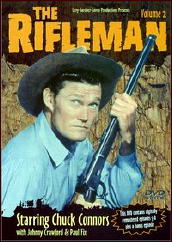
“The Mind Reader.” From The Rifleman series (1958-1963), Season 1, Episode 40, June 30, 1959. Chuck Connors (Lucas McCain), Johnny Crawford (Mark McCain), Paul Fix (Marshal Micah Torrance), John Carradine (James Barrow McBride), Michael Landon (Billy Mathis), Sue Randall (Lucy Hallager), Vic Perrin (Ed Osborne), William Schallert (Fogarty), Robert Bice (John Hallager). Writer: Robert C. Dennis. Director: Don Medford.
John Hallager and Billy Mathis get into a real dustup over Hallager’s daughter, Lucy. So when Hallager is shot to death from ambush, Marshal Torrance, with reluctance, arrests Billy as the only one with sufficient motive.
However, Ed Osborne, the town drunk, knows the truth, and he’s running scared. He begins to panic when James Barrow McBride brings his mind reading act into town, claiming that, with time, he’ll be able to name any eyewitnesses to the crime. For Osborne, that would be fatal.
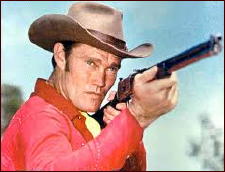
Lucas McCain is able to piece together the few clues available to him, enough in his mind to clear Billy but not enough to finger the actual killer. Then Lucy makes things worse by engineering Billy’s escape from jail, further incriminating young Mathis in Marshal Torrance’s eyes.
Lucas latches on to Osborne, in the fading hope that he’ll lead McCain to the murderer. The suspense in the last half of the show ratchets up very nicely, as Lucas bounces from one suspect to another. Finally, McCain figures out who the killer is — all of three seconds before he has to shoot him dead.
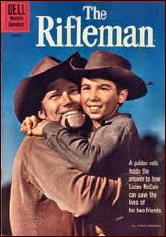
It’s pretty rare to have a genuine whodunit plot in a half hour Western, so kudos to writer Robert C. Dennis (1915-83) for this one.
Dennis had a long career of writing crime dramas for television. His credits are truly impressive: China Smith (12 episodes), The New Adventures of China Smith (12 episodes), Passport to Danger (10 episodes), Alfred Hitchcock Presents (30 episodes), Markham (4 episodes), M Squad (5 episodes), The Untouchables (6 episodes), Checkmate (6 episodes), 77 Sunset Strip (15 episodes), Perry Mason (22 episodes), The Wild Wild West (7 episodes), Hawaii Five-O (6 episodes), Dragnet: 1967 (19 episodes), Dan August (5 episodes), Cannon (6 episodes), Harry O (5 episodes), and Barnaby Jones (3 episodes).
November 28th, 2011 at 8:03 am
Wow. Given the number of TV screenplays that Dennis wrote, and how many of these series I watched when I was growing up, I’d have to say that Robert C. Dennis had a lot to do with the way I turned out as a person today.
November 28th, 2011 at 11:04 am
Saw the Ellison episode when it was first on – thought it was pretty weak. However, Ellison’s scripts were routinely butchered so who knows? Don’t know if he ever published the original script for this like he did the one for Star Trek.
November 28th, 2011 at 12:14 pm
Volume One of a collection of Harlan’s TV scripts was to have been published this fall. Volume Three contains:
Brain Movies: The Original Teleplays of Harlan Ellison Volume 3
Reprinted from Harlan Ellison’s original typescripts for the first time: his unmolested teleplay for Voyage to the Bottom of the Sea, two episodes of The Man from U.N.C.L.E., Cimarron Strip, the pilot for Ellison’s own series The Starlost (recently adapted into a graphic novel by IDW) and a bonus treatment for the Logan’s Run tv series.
Taken from http://file770.com/?tag=harlan-ellison&paged=2
Here’s where you can order the first book: http://www.cafepress.com/harlanellison
This is also relevant. Taken from http://www.casebook.org/dissertations/dst-ripfilms.html
“Jack [the Ripper] would appear briefly in several television shows in the 1960’s and 70’s. Most notably in the “Knife in the Darkness” episode of CIMARRON CITY, written by Harlan Ellison, in which the Ripper escapes to the Wild West of the 1880’s. Despite the poor adaptation of the script by the director, which Ellison has commented upon in length in AN EDGE IN MY VOICE, it uses some very viable ideas and still manages to make some limited sense regardless of the directors interference…”
November 28th, 2011 at 3:55 pm
I have fond memories of the Rifleman. It was aired in the seventies, around 6.30 pm,and the Winchester RULED !!
Goons with Colts stood nigh a chance against the semi-automatic fire of that special Winchester with the little button.
The Doc
November 28th, 2011 at 4:05 pm
Steve and Stan – With all due respect to Mr. Ellison, I think KNIFE IN THE DARKNESS is much better than Ellison gives it credit for being. Could it have been better? Is anything capable of improvement? Mais oui!
Near as I can tell, Ellison has never liked ANYTHING about ANY Hollywood productions stemming from his work. Indeed, I know of NOTHING complimentary that he’s had to say about the film industry.
His perfectionism and petulance are legendary. Given these factors, his persistently pathetic attempts to make a buck in Tinsel Town, prostituting his brilliant talents (just ask him about those), strike me as either bizarrely sadomasochistic or some sort of misguided effort at reforming a system that he sees as top heavy with Philistines.
However, he should leave temple cleansing to the experts.
November 28th, 2011 at 5:14 pm
Mike, I liked the review, especially the way you covered the plot, cast, and behind the camera story.
One wonders what Ellison expected. TV is a group art with countless people effecting the outcome. Certainly Ellison is bright enough and experienced enough to know this going in. After years of writing did he expect the business to suddenly change every time he wrote for TV? It is a shame Ellison is more famous for his mouth than his work. If he played better with others, he could have used his spare time producing more stories instead of wasting it being my generation’s “angry man.”
November 28th, 2011 at 5:53 pm
michael – Bravo! Well said.
November 28th, 2011 at 6:10 pm
To The Doc – If I count them correctly, in the opening title sequence of THE RIFLEMAN Connors fires 12 rounds in less than 7 seconds.
November 28th, 2011 at 7:43 pm
Well, Mike, THAT is fast !! It is a lot les than even older machine-guns, but for a semi, like, let us say a Mauser C-96 broomhandle, semi-automatic, of course, not the /32 full-auto, it is a an act to follow !
The wonders of TV and the movies !
The Doc
November 29th, 2011 at 9:38 am
To The Doc – You have to wonder about accuracy, too. Of course, the scriptwriters made sure Lucas McCain hardly ever missed (you know: dead main character = no more series).
I also wonder about his sustained rate of fire. After 12 shots, the barrel must be really hot. At some unknown point it’s going to deform and start to sag. That’s likely the reason, other than being a farmer, why McCain/Connors is wearing gloves most of the time.
November 29th, 2011 at 4:22 pm
On the subject of Ellison’s TV scripts, let’s not forget the great 1964 Outer Limits installment Demon with a Glass Hand, starring Robert Culp as a cyborg who believes he is a man and is dispatched back in time to save the human race from an alien invasion — which I would call one of the television’s earliest examples of “tech noir.”
November 29th, 2011 at 5:31 pm
Until he trademarked himself, I’ve always been a Harlan Ellison fan, and even so, I probably still am. (I don’t disagree with any of the previous statements made about him, positive or negative!)
http://www.sfsignal.com/archives/2006/04/harlan-ellison—registered-trademark/